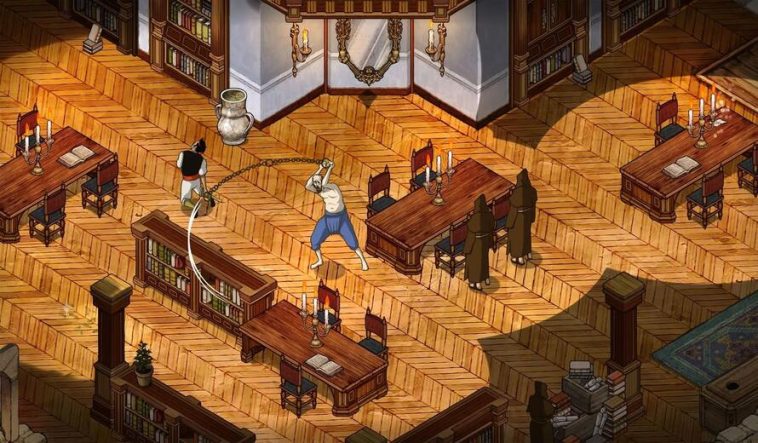The Stone of Madness Review
The Stone of Madness is just another game chasing trends. We’re sick of all these games set in 18th century monasteries. There are far too many real-time stealth strategy games centered around a crew of madmen escaping an asylum. Gamers have had enough of character art inspired by the works of Spanish painter and printmaker Francisco Goya.
I jest, of course. The recent trend of video games inspired by medieval life is a delightful invention of the last couple years.
In 2022, Obsidian released Pentiment, which follows a journeyman illuminated manuscript artist in 16th century Bavaria comes to mind. So does Indika, last year’s title about a Russian nun doubting her religious convictions through puzzle-platforming gameplay. Until this trend, the Middle Ages were far more likely to feature magic-wielding popes than meticulously detailed representations of living in that era.
Where Pentiment and Indika are story-first narrative adventure games — some would unkindly call them walking simulators — The Stone of Madness is not. No, inside The Stone of Madness’s despairing medieval package lies an isometric real-time stealth strategy game. Choosing from five bona-fide lunatics with each mission, players use their various madnesses and manias to solve the haunted mysteries at this demented monastery’s core.
Hats Off to the Cast
The first character we meet is Alfredo, a priest who’s been wrongfully imprisoned in an insane asylum for investigating corruption in the church. Armed with his wits and a distractingly stupid hat, Alfredo teams up with a violent violinist, a quietly tortured strongman, a devil-obsessed witch, and a precocious orphan.
Each character comes with weaknesses — Alfredo can’t stand to be near corpses— and unique strengths, like Alfredo’s sermons, a priest disguise, and literacy-fueled investigation skills. Players can use different combinations of these abilities to inch their way forward in the tightly interwoven story.
Managing five sets of skills and fears are far from the only gameplay elements at play. From glaring gargoyles to gun-toting guards, players must keep an incredible amount of moving parts in their head. A clearer quest log would clear things up. When I played when
As the day wears on, the guard patrols change, giving players new opportunities for exploration — not to mention requiring them to learn more gameplay patterns. During the night, the characters help each other rest, recharge, and prepare for another day.
Get Ready For a (Cart) Ride
The Stone of Madness’s complexity means it isn’t a drop-in kind of game.
The huge number of options at my disposal caused me forgot about certain abilities between sessions, rendering my progress slow and inconsistent; A more in-depth quest log would clear things up. Guards caught me at every turn, even when I was halfway through a tunnel. Certain decisions still don’t make sense to me, namely the addition of traps to the monastery’s common spaces. If the characters are allowed to be there and they’re not being arrested on sight, why would the guards put traps out for them? It seems inconsequential until you’ve been caught in one during a crucial escape. When a game demands this much, it needs to be perfect.
Minor performance issues plagued my experience. Twice, the game’s struggle to load all its moving parts into my Steam Deck brought about a progress-losing crash.
Humanizing the Humors
At first, The Stone of Madness’s gamifying of real-world diseases and disorders had me fearing the worst. But instead Enlightenment-era edgelords, I found a surprisingly touching narrative.
The Stone of Madness treats each of its characters like fully fledged people. Each, including the wrongfully incarcerated Alfredo, finds their mental health worsened by the historically accurate nightmare of an 18th century asylum. Nighttimes bring the motley crew together, with players controlling how they care for another. In doing so, The Stone of Madness earns that elusive found family without sacrificing its edge.
Once it clicked, I could hardly put The Stone of Madness down. The game’s detailed Goya-inspired art direction is just gorgeous. When everything works, all the hard work you’ve put in to make it to the next plot point pays off. It’s so much easier to list out negatives instead of quantifying success, but The Stone of Madness is a compelling, largely successful stealth challenge.
Set in a wonderfully creative, surprisingly sensitive portrayal of a time period as human as any other, The Stone of Madness is a real gem in the mind of those who play it. At some point, I even stopped noticing Alfredo’s stupid hat.
***The Stone of Madness key for PC provided by the publisher.***
The Good
incricate gameplay
unique premise, gameplay
stunning art direction
strong characters
sensitively handled
80
The Bad
overcomplicated
unfairly punitive
minor performance issues





GIPHY App Key not set. Please check settings